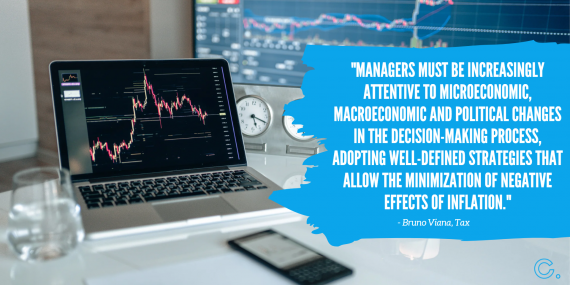Decision Making in inflation times
Thus, inflation has become a recurrent theme in the media, with forecasts currently reaching 4.4% in Portugal, 8.1% in the European Union, 9% in the United Kingdom and 8.3% in the United States.
Governments and Central Banks, aware of the impacts that inflation has on the population, are looking for measures to deal with this phenomenon. The American Central Bank has already informed that it plans to stop its policy of buying “Bonds” and a possible increase in interest rates to three times the current ones. This policy will also imply damage for companies and consumers, as it implies greater difficulty in obtaining credit, which reduces demand in certain economic sectors, namely housing and automobiles, eventually impacting the economy as a whole. To combat the enormous difficulty in obtaining semiconductors, indispensable elements in the automotive industry and in the most varied technological industries, the European Union and the United States have announced a bilateral convention to guarantee stability and greater production in these territories, ensuring greater independence from other blocks and protecting their economies.
On a business level, due to high inflation, companies are faced with the need to make decisions to achieve the desired financial results. The most common measure is to raise the prices of their products, but this strategy will lead consumers to consume less, especially if the product is not considered essential. Thus, many companies look for ways to make the impacts of inflation more “invisible” to consumers.
The first of these measures is to reduce non-essential costs along the value chain, namely by sourcing certain components and raw materials in Portugal or the European continent, to the detriment of other continents, due to the very high costs of sea and air transportation.
In other industries, such as the bicycle manufacturing industry, with a high percentage of bicycle production concentrated in a single location (Taiwan), high costs and logistical and transportation problems, combined with a high demand since the pandemic period, led brands, in order to maintain their profit margins, to implement a strategy where they offer bicycles at prices similar to previous years, however, integrating lower range components.
Another less visible measure already implemented by certain companies is the so-called “shrink inflation”. Shrink inflation becomes invisible to the consumer as companies maintain prices but slightly reduce the size of products, thus reducing their production cost. This phenomenon appears more and more recurrently in the food, beverage, and hygiene products sectors.
Thus, and taking into account that each business is subject to distinct variables, managers must be increasingly attentive to microeconomic, macroeconomic and political changes in the decision-making process, adopting well-defined strategies that allow minimizing the negative effects of inflation.
